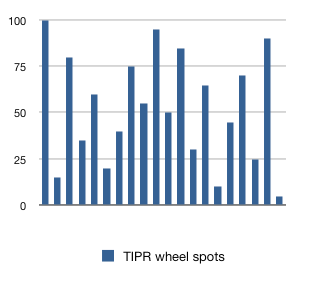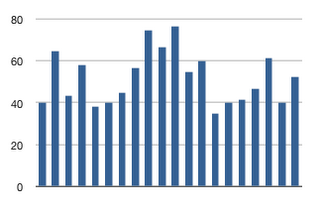The wheel is, more or less, just like a Wheel of Fortune turned on its end. There are 20 sectors on the wheel numbered in multiples of 5 cents up to a dollar. Your goal is, in one spin or two, to get closest to a dollar without going over. Get a dollar exactly and you win $1000.
While this may seem random, the important difference between this wheel of fortune and the ones in Nevada is that you get to spin it, rather than a croupier. That means that the velocity of the wheel is under your direct control. And the velocity of the wheel and its decay function are the only things that control where it is going to land.
First question's first: Where do you want it to land? Obviously you'd like to land it on the dollar on your first spin and be done with it, but the reality of the situation is that perfect control is going to be almost impossible. If you actually graph the wheel's positions, you'll see that they were not chaotically arranged.

You can see that they alternate high and low numbers to some extent, but there's an even more important pattern. It emerges somewhat better if you graph the average of each spot's value with its two neighbors:

That's pretty evil. Assuming you don't win the dollar on your first spin, you want to either spin a very high number or a very low number. The "death zone" is in the 40-60 or so range. On the low end, you're forced to spin again where you have almost an even money chance of going over, and on the high end you're forced to stand with an excellent chance that your following opponents will beat you. But you can see from both curves that the sweet spots are separated into two pieces near the beginning and end of the wheel. The "back" of the wheel is particularly dangerous territory for the first spin, as it has a high average, which is dangerous for a potential second spin.
So the ideal strategy is to aim for the front half of the wheel for your first spin, as you'll have a shot at the dollar spot, but more importantly you'll be more likely to land on something big or small. Then if you hit low on the first spin, aim for the back half of the wheel where there are only a couple of potentially dangerous numbers and lots of medium sized numbers that will boost your total to a safe range.
Well, that begs the question - If you know exactly how many sectors you must move the wheel from its current spot, how hard do you spin it so that it lands where you want? For that, we need to work out the decay function of the wheel and do a little math and figuring. The first half of that assignment will require a bit of time with a few TiVo'd episodes and some audio capture software. I'll get back to you...
2 comments:
Hi...where are your pictures/graphs?
They're there. If you can't see them, then maybe something's wrong on your end?
Post a Comment